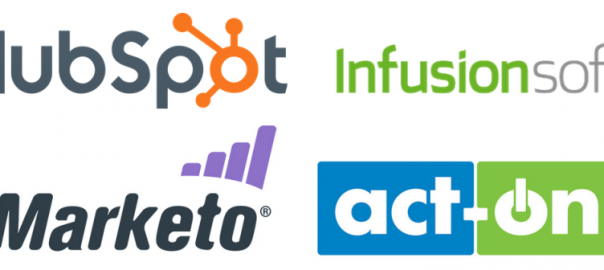In recent months I’ve noticed a lack of content dedicated to marketing automation platforms and SEO. Most platforms, like Infusionsoft and HubSpot, have great content on general SEO best practices but there seems to be a gap in content that explains how to best use a marketing platform to support a site’s broader SEO efforts.

Specifically, there remains a lingering question on how to best use best subdomains and subdirectories in order to benefit your site’s overall SEO efforts.
In this post, I’m going to offer some insight into how to best use marketing automation platforms for SEO and how to avoid some of the most common pitfalls. But first, let’s take a step back and remember why marketing automation platforms came into existence and put their value into the right context.
The Real Benefits of a Marketing Automation Platform
Marketing automation platforms combine many of the features of singular marketing tools in one package, take these examples to name just a few:
- Unbounce (landing page creation, A/B testing)
- Moz (keyword tracking, SEO on-page optimization checks)
- MailChimp (email marketing)
- WordPress (CMS)
- Hootsuite (social media management)
- Google Analytics (content performance)
- Google AdWords (PPC performance)
Whew! That’s a lot of different tools running at the same time, all trying to solve the same objective: drive traffic, deliver great content, generate leads, and turn those leads into customers.
Prior to the explosion of marketing automation platforms, we marketers were stuck managing campaigns across multiple tools that often didn’t speak to each other and had varying degrees of automation. Much of our time was spent on implementation instead of actually measuring results.
The goal of marketing automation tools is to drive traffic, deliver great content, generate leads, and turn those leads into customers.
Plus, analyzing the results of our campaigns – the most important part of marketing – was a nightmare. Remember trying to aggregate data from these tools into standard reports? A place where we could draw visitor and lead insights? Yeah, me neither. Features like lead intelligence and dynamic smart forms just weren’t possible for the average marketing team.
Marketing automation platforms are extremely beneficial. They allow you to combine multiple marketing tools into one home, set up complex automated processes, and seamlessly gather anything from basic analytics to comprehensive visitor and lead intelligence. That’s a huge win for digital marketers and absolutely worth the investment for most businesses.
So What’s the Catch? It’s All About the Landing Pages
The details are critical when using a marketing automation platform and we find we get the most questions on how to use landing pages correctly with these types of platforms. Most users aren’t sure if they should set up a subdomain to house all of their newly created gated content or use a subdirectory on their website.
 (Source: Formstack)
(Source: Formstack)
To understand which is right for you and your site, it’s important to know how marketing landing pages should be used.
SEO Best Practice: How to Use Marketing Landing Pages
Marketing landing pages should be created on a subdomain and used for individual marketing offers used for lead generation capture and testing — that’s it. Here’s why it’s best practice to create marketing landing pages on subdomains versus a main top level domain
- Marketers don’t have multiple versions of the same offer in a site’s subfolders (avoid duplicate content)
- Subdomains can be masked with custom URLs not part of a main site structure (info.yourwebsite.com or demo.yourwebsite.com)
- Subdomains are treated as separated sites so the content produced is only narrowly attributed to the corresponding top-level domain. This creates a “playground” for marketers to test offers.
- Efforts made to optimize a top-level domain do not significantly impact subdomain authority and vice-versa.
Marketing landing pages live on a subdomain for a distinct purpose that benefit both the marketers and your SEO team by creating a test friendly environment to create lead generation offers. Marketers should not use a subdomain to replace any content that lives in a top-level domain.
Marketing landing pages should be created on a subdomain and used for individual marketing offers used for lead generation capture and testing — that’s it.
Here’s what happened to Timo Reitnauer when he started using a subdomain to house his company’s content. Big drop, right? Recent reports show his content still hasn’t quite recovered 6 months after moving it back to their top level domain.
Landing pages created through marketing automation platforms should not be the home of the SEO-rich content you create. Instead, they are the right place for you to promote that content for lead generation.
SEO Best Practice: Where Your Authoritative Content Should Live
Here’s where it gets a bit confusing. Most marketing automation platforms give you the ability to “optimize” your marketing landing pages for search engines. However, it’s important to note that while these platforms can give us marketers SEO “grades” and do really help track SEO performance, the use of a subdomain to publish landing pages is not intended to house the valuable, authoritative content that should live on a business’ main website (top level domain).
For most marketers, it should not be your goal for the subdomain to rank organically. You want to build up the domain authority on your main website using that amazing content you’re spending so much time and money creating.
“[Subdomains] act as a barrier for the full link equity, brand, and user/usage signals to pass to your main site. They don’t amplify; they diminish your ranking/visibility potential”
– Rand Fishkin, Founder of Moz
We recommend creating SEO optimized, organized resource pages that house your authoritative pieces on your top-level domain, like free guides, webinars, interviews, and blog content. Be sure to pay special attention to the URL structure, the keywords on the page, and the length of your content.
Use your marketing landing pages on a subdomain to test out different messaging and calls-to-action. When you split out your content this way, your marketing efforts won’t conflict with your long-term SEO goals.
Driving Traffic to Marketing Landing Pages
It’s important to note: with marketing landing pages, you do have to drive traffic with social, PPC, or other referral traffic.
“Optimizing” these pages for SEO is a best practice in theory — as you would any published web page – but in reality, totally unnecessary. It’s a bit misleading that some of these platforms use phrases like, “enter keywords into your landing page” as if you are truly optimizing the page. Most of the time, your marketing landing pages will need a paid source of traffic or volume from a popular referral network, like email or a third-party site linking to your offer.
Subdomains vs Subdirectories: FAQ

Before we close, here are the answers to the most common questions we receive about properly using subdomains with marketing landing pages.
When should I use marketing landing pages on a subdomain?
Use a marketing landing page on a subdomain when you want to test different offers. Maybe you want to do an A/B test with copy or call-to-actions, or perhaps you want to create an offer just for your Facebook fans or Twitter followers. When you use a subdomain you don’t have to stress about affecting your top level domain with duplicate pages or content.
Use marketing landing pages on a subdomain when you want to isolate these pages from the rest of your primary website.
If you only have one offer on a page that will rarely change – say a request for a standard product demo on your top level domain – you could use a subfolder to house that page. Keep in mind though, that using a page on your subdirectory has ripple effects to your top level domain. Create these pages with as much effort and thought as you would any other main page on your website.
Should I link to my subdomain marketing landing pages from my top level domain?
You can if it’s appropriate for the lead generation offer you’re providing on your subdomain. While the outbound links from your top level domain to your subdomain won’t negatively affect your SEO efforts, I’d only recommend this tactic if it makes sense for you from a conversion perspective.
However, it’s important to emphasize that your authoritative content should not live on a subdomain. If you want to drive people to a gated free guide offer on your subdomain, make sure that free guide primarily lives somewhere on your main website on a dedicated page.
Do I need to use noindex and nofollow tags on my marketing landing pages?
I would use noindex if you want to direct Google not to index your landing pages. Nofollow tells Google not to apply link equity to the content so its use depends on if you want stand behind the content offered on your marketing landing pages.
This seems like a lot of work. Why would I even use marketing landing pages at all?
Using marketing landing pages correctly can feel overwhelming and a bit confusing. Some of our clients request to just use their top level domain to house all of their lead generation offers. And for many of them, it makes sense. The deciding factor here is flexibility and testing.
A subdomain allows you to test all different types of variables that go into generating conversions. Building marketing landing pages on a subdomain gives us the flexibility to test varying versions of pages. We also can create as many of these landing pages as we’d like without significantly affecting our top level domain SEO efforts. Now, this doesn’t give us a justifiable reason to create spam-filled pages, but it does give us a safe playground to test different approaches.
If you don’t plan on changing your marketing landing pages very often or you want to create just one page with a call-to-action form and focus on building up the page authority of that offer, you can just use a subdirectory. The use of subdomains are not required with marketing landing pages.
In the end, it all comes down to how you plan to use your marketing landing pages to decide on whether you should select a subdomain or a subdirectory for your offers.
SEO and Marketing Automation Platforms: The Good News
The good news: marketing automation platforms do let you track the SEO performance of your top level domain and grade individual top level domain pages for SEO – this is very similar to something like a Moz On-Page Grader. Some even come with helpful site and page-level keyword trackers.
I truly believe there are some powerful and helpful SEO tools within these platforms that should definitely be utilized. Marketing landing pages are just not one of them.
(288)
Report Post








